A 2,000-Year-Old Engineering Marvel That Still Works Today
When summer storms hit western Sichuan, rivers swell, roads flood, and fields drown. But in the heart of this chaos, the waters of the Min River suddenly become calm and orderly, as if an invisible hand is guiding them. This is the magic of Dujiangyan—a water management system built over 2,000 years ago that still controls floods, irrigates fields, and sustains life in Sichuan.

So, what makes this ancient dam-free water system so special? And why is it still crucial for Sichuan today? Let’s dive into the fascinating history and engineering of Dujiangyan.
The Genius Behind Dujiangyan: Li Bing
Around 270 BCE, Li Bing, a brilliant hydraulic engineer, was sent by the Qin king to govern Shu (modern-day Sichuan). At that time, the Min River, originating from the Min Mountains, frequently flooded the Chengdu Plain, making it difficult for people to farm and thrive.
Li Bing knew that simply building dikes wouldn’t solve the problem. Instead, he proposed a bold plan: to redirect and regulate the river without using a dam. He chose a location near present-day Dujiangyan city to carry out his ambitious project.
The Three-Part Water Management System
Dujiangyan consists of three key components, each serving a crucial function:
- Fish Mouth (Yuzui) – A levee that splits the Min River into an outer channel (for flood control) and an inner channel (for irrigation and water supply).
- Flying Sand Weir (Feishayan) – A spillway that allows excess water and sediment to flow back into the outer channel, preventing silt buildup.
- Bottle Neck Channel (Baopingkou) – A narrow, man-made channel that controls water flow into the Chengdu Plain, ensuring a stable supply for irrigation.
With this innovative design, the system automatically adjusts to seasonal water changes, preventing floods during the rainy season and ensuring a steady water supply in dry periods. It’s an ancient engineering masterpiece that requires minimal maintenance yet remains highly effective.
How Dujiangyan Shaped Sichuan
Thanks to Dujiangyan, the once flood-prone Chengdu Plain transformed into one of China’s most fertile agricultural regions. The abundance of food and resources allowed Sichuan to grow into an economic and political powerhouse. Even the Qin dynasty, famous for its military strength, relied on Dujiangyan for grain supply when it conquered rival states like Chu.
Later, during the Three Kingdoms period, Zhuge Liang used the system to sustain his armies, and in the Ming Dynasty, the prosperity it brought helped create one of China’s wealthiest royal treasuries—the Sichuan royal court.
The Legacy Lives On
Today, Dujiangyan is not just a functional water system but also a UNESCO World Heritage site and a popular tourist attraction. Visitors marvel at its ancient yet sophisticated design, which still provides water to over 30 counties in Sichuan.
So next time you enjoy a hotpot in Chengdu or admire the lush landscapes of Sichuan, remember: none of this would be possible without Dujiangyan. It’s not just an ancient relic—it’s a living, breathing lifeline that continues to support millions of people, just as it has for over two millennia.

No comments yet.